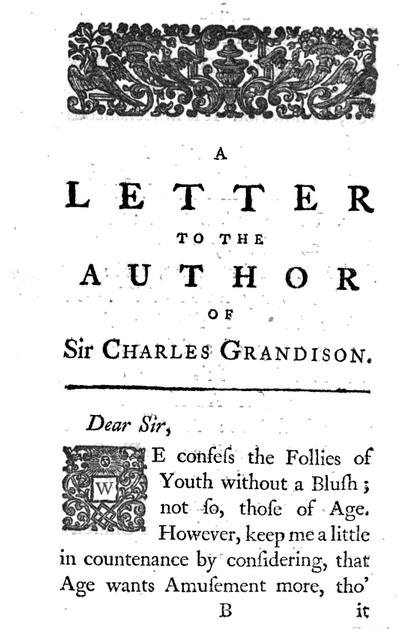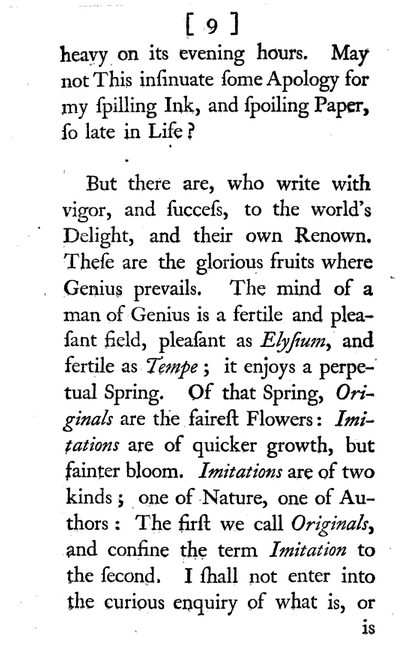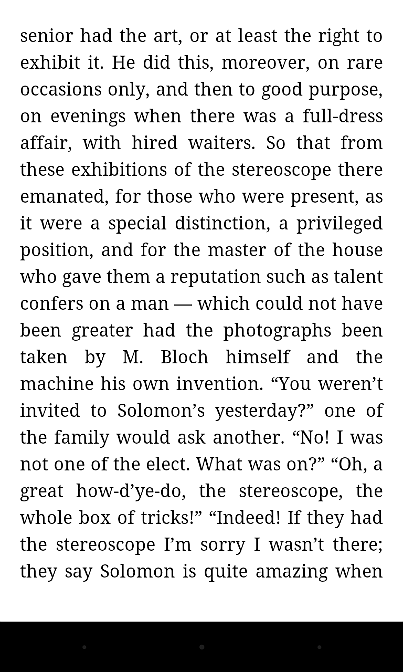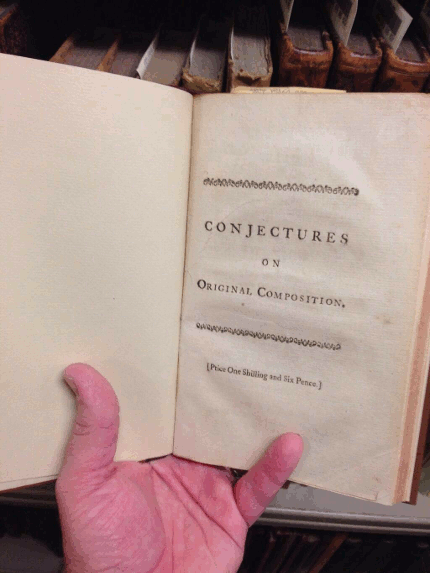
« PREVIOUS ENTRY
A video game for an audience of one

That’s one of the opening pages of Conjectures on Original Composition, a book about creative genius published by the English poet Edward Young in 1759. It’s considered one of the first big essays to tout the idea that “originals” — writers of deep originality — are more important and awesome than derivative folks. I heard about Conjectures while reading a different essay this evening, and since I’m sort of obsessed with tracking the rise of our modern (and disastrous) conceit that originality is something that just kind of wells up from inside you I immediately dialed up Conjectures on Google Books to read it. It’s a delightful essay, but what struck me immediately was its design: Those tiny pages, crammed full of large-fonted prose.
It looks just like a book displayed on a smartphone screen.
That small-page format was quite common back in the 18th century. It’s known as octavo duodecimo — with pages that are about 6 inches by 9 inches. The entire Conjectures is only about 8,000 words long, but it was common to print essays in this pretty little style, because it had great ergonomics: It made for easy one-handed reading and portability.
Pretty much the same advantages as reading on a smartphone, when you think about it. When it comes to books, I read about half my stuff these days in print, and half in e-format; and while I own a Kindle, I don’t use it very much any more — I just read ebooks on my Android phone. Indeed, reading on my phone has led me to read more books than ever, because the octavo-esque portability means the books are ever with me: I dip in and out while riding the subway, waiting in line at a store, lying in bed falling asleep, or lying in bed awake with “early waking insomnia”, yay. The portability has made it possible for me to read books sufficiently huge that, had I’d been forced to carry ‘em around, I’d probably have ditched out and never finished them — things like War and Peace, Middlemarch, and Moby Dick, all of which I read entirely on my smartphone.
In fact, one of the oddly useful things about reading War and Peace on your phone is that the octavo-like format makes the epic enormity of the tome less intimidating: It’s just one little page after another, each one oddly inviting. I tend to blow up the font on my phone to quite large, so each page has only a few hundred words on it, precisely the way that Conjectures is laid out. Here’s a page of Conjectures …

And here’s a page of a book I’m currently reading on my smartphone (sorry for the crappy resolution of the font, which looks weird when I size it comparably):

The point being, of course, that the ergonomics of smartphones as reading devices are not only kind of rad, but historically so.
These small formats from days of yore also help explain the stupendous productivity of many historic authors. I’ll often be reading about a nonfiction essayist from the 17th or 18th or 19th century and the bio will mention he or she wrote 56 books or some other ungodly number, and I’ll freak out: Man alive! How can anyone generate so much?
But then you realize that a “book” back then wasn’t what we think of as a “book” now. Back then, there were a plurality of book-sized formats that were, like octavo or the slightly-smaller duodecimo, pretty compact, so these “books” were only a couple of thousand words long. (Like the totally fun The Art of Memory by Marius D’assigny, from 1706.) Authors who cranked out 40 “books” were actually writing pieces that are closer to a long magazine article.
It wasn’t until the 20th century arrived that nonfiction books started to congeal into the 300-page quantum, for a host of economic and cultural and industrial reasons. To wit: If you’re going to charge someone $25 for a hardcover nonfiction book and do it via industrial publishing, you have to make the customers feel they’re getting $25 worth, which means the book has to be loooooong … even if the author does not possess an argument requiring 300 pages. (Thus we find so many books that are really just magazine articles gasified to fill the container.) The emergence of digital formats for books is changing these industrial economics, with some pretty cool aesthetic and intellectual effects. If you don’t need to charge $25 for a book, you don’t need it to necessarily balloon to 300 pages, so you can begin to publish books that look more like … Conjectures or The Art of Memory. The book fits the length of the utterance, instead of expanding to fill a vessel the dimensions of which were determined by haptic marketing: “Yeah, this book feels weighty. I’m in!”
Part of what made me think about these cool, short, old book formats is that the recent discussion/debate about “long form” writing. I’m thinking particularly of Ben Smith’s terrific meditation on how they’re integrating longer pieces into Buzzfeed. As he notes, when you don’t have an artificial constraint, form fits function: “This is more like book-writing, less like the compromises of magazines and newspapers …”
The only thing I want now is for someone to sample those amazing fonts they used for Conjectures and The Art of Memory, and instal them on my phone. Holy moses, the fonts that come with the Kindle app on Android are flavorless. Look at the gorgeous fontistry of those old books! Just look at it!
UPDATE: In this post I originally misidentified the size of the book as duodecimo size, 5 inches by 7 3/8 inches; then John Overholt, a curator of early modern books at Harvard, pulled a copy of Conjectures out of his stacks to verify the dimensions: Check out John’s excellent comment below, which I’ve excerpted. Thanks John!
The Essay is actually a small octavo, the next size up from duodecimo, which I have the sense would have been a little beneath the dignity of such a piece. I did see that there was also a pirated Dublin edition in 12mo in just 60 pages, which would have been set in a much smaller type, to keep the book considerably cheaper than the 1£ 6s of the London original.
Bonus: John snapped this shot of himself holding the book:

I'm Clive Thompson, the author of Smarter Than You Think: How Technology is Changing Our Minds for the Better (Penguin Press). You can order the book now at Amazon, Barnes and Noble, Powells, Indiebound, or through your local bookstore! I'm also a contributing writer for the New York Times Magazine and a columnist for Wired magazine. Email is here or ping me via the antiquated form of AOL IM (pomeranian99).

ECHO
Erik Weissengruber
Vespaboy
Terri Senft
Tom Igoe
El Rey Del Art
Morgan Noel
Maura Johnston
Cori Eckert
Heather Gold
Andrew Hearst
Chris Allbritton
Bret Dawson
Michele Tepper
Sharyn November
Gail Jaitin
Barnaby Marshall
Frankly, I'd Rather Not
The Shifted Librarian
Ryan Bigge
Nick Denton
Howard Sherman's Nuggets
Serial Deviant
Ellen McDermott
Jeff Liu
Marc Kelsey
Chris Shieh
Iron Monkey
Diversions
Rob Toole
Donut Rock City
Ross Judson
Idle Words
J-Walk Blog
The Antic Muse
Tribblescape
Little Things
Jeff Heer
Abstract Dynamics
Snark Market
Plastic Bag
Sensory Impact
Incoming Signals
MemeFirst
MemoryCard
Majikthise
Ludonauts
Boing Boing
Slashdot
Atrios
Smart Mobs
Plastic
Ludology.org
The Feature
Gizmodo
game girl
Mindjack
Techdirt Wireless News
Corante Gaming blog
Corante Social Software blog
ECHO
SciTech Daily
Arts and Letters Daily
Textually.org
BlogPulse
Robots.net
Alan Reiter's Wireless Data Weblog
Brad DeLong
Viral Marketing Blog
Gameblogs
Slashdot Games